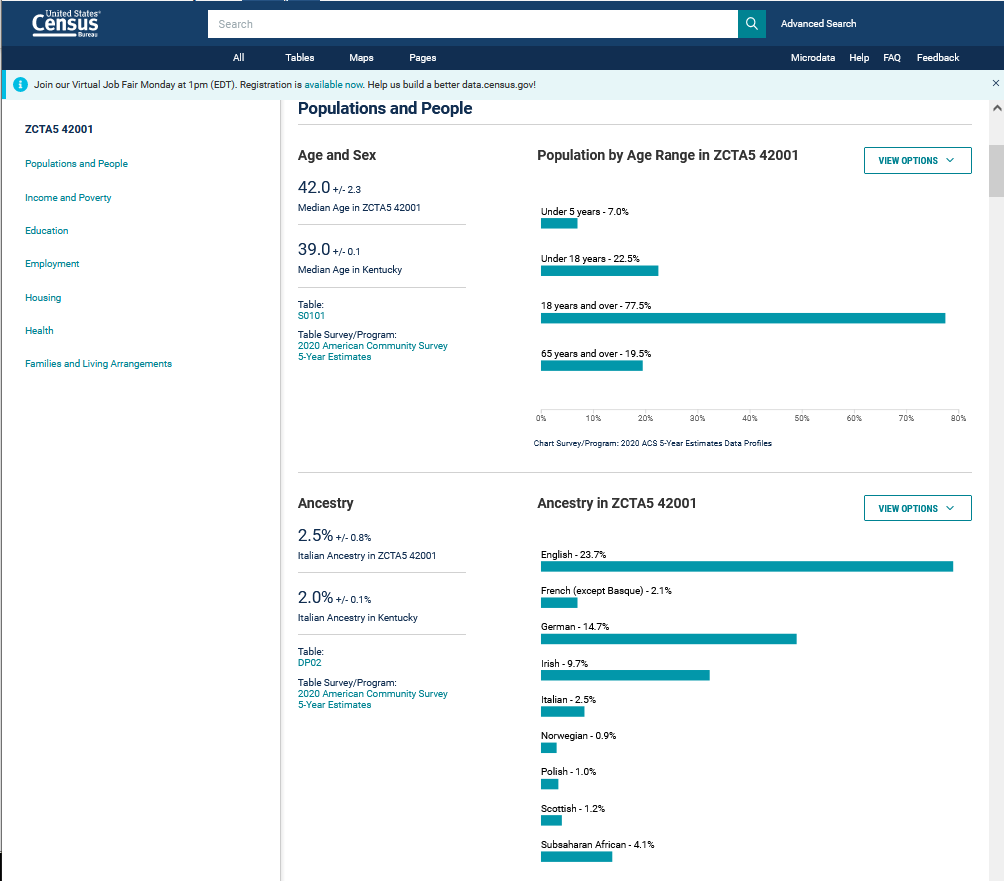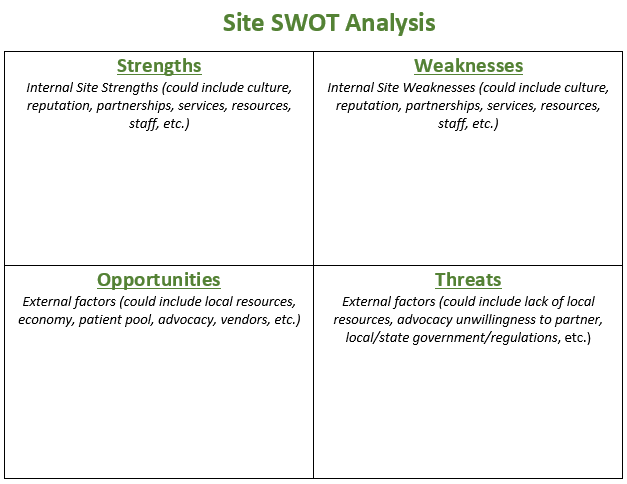A Community Assessment starts by gathering all of the data available on the community.
Community Statistics:
A good starting point for gathering data on your community is the US Census Bureau website.  Simply put your zip code in the search box, then click on the map on the right-hand column of the page. This should bring you to a page with statistics on the local population’s age, ancestry, income, poverty, education, employment, and housing.
Simply put your zip code in the search box, then click on the map on the right-hand column of the page. This should bring you to a page with statistics on the local population’s age, ancestry, income, poverty, education, employment, and housing.
Another great resource is SparkMap. SparkMap offers free location-specific data to create maps and community assessments with data, indicators, data visualizations, and benchmarks related to health, economics, environment, education, demographics.
Community Services:
Next, collect a list of local services available in your community. Include advocacy organizations like local MHA, NAMI, or DBSA chapters, soup kitchens, homeless shelters, employment resources, day treatment centers, and youth centers. Also include local psychiatric hospitals/units, crisis centers, and recovery centers. Churches frequently provide services to the community, so you can check with them, as well.
Contact your local government and ask what services they provide. That could include housing, medical support, transportation services, etc. Check with the local police — do they have mental health resources? Are they prepared to handle any 988 mental health calls? What resources can they suggest?
Finally, speak with your patient volunteers — what services do they utilize within the community? They may know of community kitchens, healthcare clinics, or support organizations that aren’t on the radar.
Along with the local government websites, there are a few national websites with searchable lists of nonprofits and community service organizations. Here are a few:
Other Services Requested by Volunteers
You know that patient volunteers sometimes require transportation assistance, but what about childcare or elder-care while they are at appointments? Do they need any type of documentation for their jobs? Interpreter services? Help paying their bills? You can uncover these needs with a simple volunteer survey (coming), given at various times throughout the trial. Once these services are determined, you can respond to these needs by partnering with an existing organization that provides these services or you can offer them at the site.
Analysis and Action Plan
It is one thing to gather the data, but if you don’t use it, you aren’t leveraging the full value of the exercise. You need to analyze the data and determine findings for your Action Plan.
Now that you have the demographics of your community, take a look at your site staff. Do they correspond? If your community has a large Hispanic or African American population, you will be in a better position to access those groups if you have Hispanic and/or African Americans on your staff.
Are there services offered within the community that your site or your patients may want to utilize or support?
What can your site offer to specific segments and/or organizations within the community that will help promote your site and build trust within the community?
Once you’ve analyzed the data, create a plan to leverage the resources within your community for the benefit of the community, the patients your serve, and for the benefit of your standing within the community.
Keep in mind that The STARR Coalition is happy help with any part or parts of the Assessment, Analysis, and/or Action Plan! We’re here to help make you as successful as possible!
SITE SWOT ANALYSIS
Strengths and Weaknesses are defined as internal factors your site currently possesses such as:
- Company culture
- Staff Diversity
- Reputation
- Partnerships
- Assets
- Resources
- Employees and Leadership
Weaknesses and Opportunities are defined as external factors which come from the larger environment surrounding your site such as:
- Medical providers
- Economy
- Potential Volunteers/Current Volunteers
- Advocacy
- Vendors
- Legislation/Regulations
There is no objective way of measuring how well you do a SWOT analysis. It is simply observing internal and external factors that can impact your site. It’s not about making accurate predictions; it’s about knowing what to plan for.
There are several steps in creating a SWOT analysis.
- Gather the right people- While many decisions are made by upper management, it is important to open this process to all people with interest in your success as a site, even people who don’t fully understand your business. Including as many employees as possible will increase the buy-in and broaden valuable insight.
- Host a brainstorming session- Gather your team and list all strengths, weaknesses, opportunities, and threats (better with smaller teams) or have individuals make their own lists (better with larger teams). Write everything down, do not begin to close out ideas at this point.
- Fill the gaps- Once ALL ideas are on the table, come up with four big lists. Start filling in the gaps and determine how important each item is on the list. Ask each person to choose their top three items from each category. Most likely, patterns will emerge.
- Narrow the lists- Begin to fit all your ideas on a single page (included in module). Keep larger list for future review.
- Create strategies- For each item on the final list, create a strategy to exploit the advantages and opportunities and deal with the weaknesses and threats. Keep the plan broad. When ask yourself the following: How can you use your strengths to improve your weaknesses? How can you exploit opportunities to neutralize your threats? Can you leverage your strengths to better take advantage of opportunities? Is there a weakness you need to prioritize in order to prevent a threat?
Once you’ve worked out the most important items, flesh out your action plan and start the work.
Sites have used this concept to proactively:
- Support local advocacy by joining boards, using site staff for helping educate advocacy and families about medicine, research, complexities of indications, etc.
- Providing funding for advocacy, participating in community events, building partnerships with medical providers and treatment facilities, etc.
- Utilize outreach into new areas of the community not previously explored.
- Design plans to become community leaders in research education and outreach.
Sites have also come across barriers as well:
- Resistance from advocacy to become associated with research.
- Medical and treatment community hesitant to educate consumers about potential research opportunities.
- Cautious when associating with research due to stigma around research.

Vetting a Nonprofit Organization
As you are collecting information on local resources, you’ll want to make sure that they are legitimate resources. There are a few ways to vette a nonprofit organization:
- Look at their history, funding sources, and any news stories on them.
- Check out their website and social media platforms, including any published articles.
- Talk to other donors And volunteers.
- See how transparent they are. You can request their financials and/or oganizational information or check GuideStar.
- Volunteer or go to an event they host.
